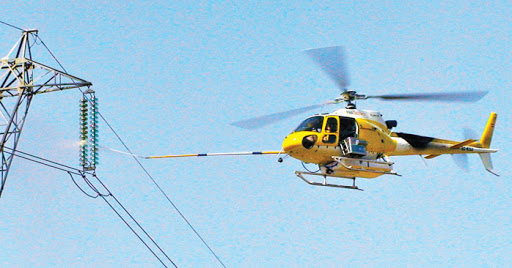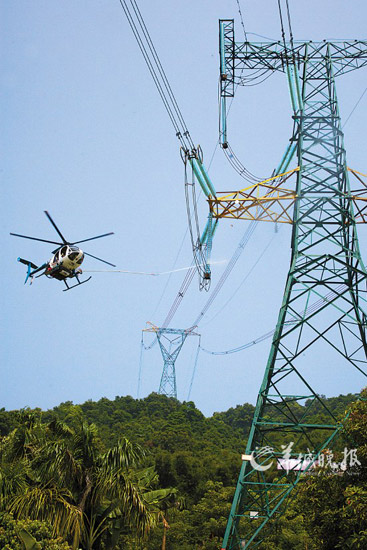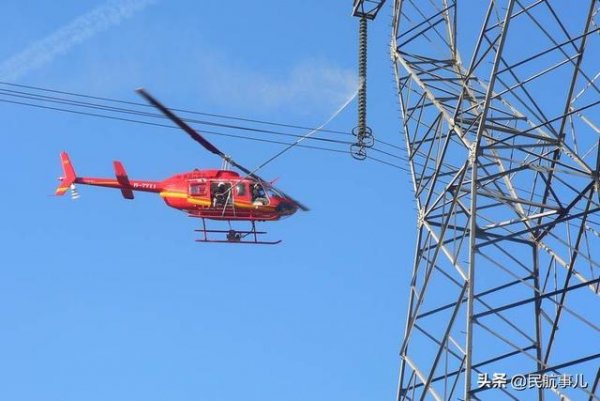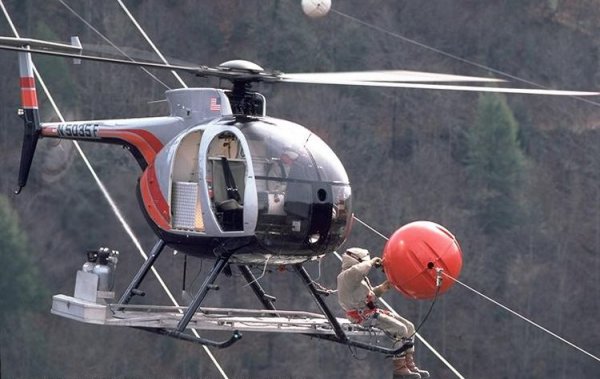Live work with a helicopter
Live work means an activity in which the worker comes into direct contact with energized lines (or equipment) or works on energized lines (or equipment) using special work tools, equipment (or devices), to perform maintenance and testing of lines (or equipment) live. This measure is effective in avoiding power outages during maintenance and ensuring uninterrupted power supply.
Depending on the relationship between the electrician and live parts, that is, whether the live part comes into direct contact with parts of the electrician's body, the live work method can be divided into two main methods, namely: contact work and remote work ; According to the potential of the worker's body, the production of live work can be classified as follows: the production of work under the ground potential, the production of work under the medium potential and the production of work with equalization of potentials.
Live helicopter work is mainly used on EHV transmission lines for the following types of work:
Washing live insulators with a helicopter
With the increase of power line voltage and the development of long-distance power transmission, the washing of live insulators using a helicopter has become widespread, which is mainly suitable for washing insulators of ultra- and ultra-high voltage power transmission lines with direct and alternating current.
This method effectively reduces the overlap of insulators caused by contamination and improves the insulation level and operational reliability of the power grid. Countries and regions such as North America, Europe, Australia, Israel and Japan widely use helicopter cleaning of live insulators. Taiwan and Hong Kong have been cleaning helicopters on live insulators for several years.

In late 2004, China Southern Power Grid demonstrated helicopter cleaning of live insulators. In recent years, helicopter cleaning of live insulators has been successfully carried out in Hunan sections of UHVDC transmission lines that are fed by the North China Power Grid and the Three Gorges Hydroelectric Plant.
When washing live insulators with a helicopter, deionized water with a resistivity of 10,000 Ohm • cm is usually used, and for this purpose you can purchase deionized water or purchase a filter to produce deionized water. The insulated water cannon comes in two types: short cannon and long cannon. The flow rate of the washing water is approximately 30 l / min, and the pressure in the nozzle is approximately 7-10 bar.

Production of live works with equipotential bonding using a helicopter
In 1979, Michael Kurtgis of the USA was the first to attempt live work with equipotential bonding using a helicopter. In the 1980s, the United States, Canada and Australia successfully developed a way to perform electrical work by inspecting power lines to live equipotential bonding using a helicopter, taking a major step forward in the electrical operation of helicopters.
Carrying out live work with equipotential bonding using a helicopter has proven the feasibility of its application in practice. This method can be used to identify defects in zero-distance equipment, including defects in connecting components, conductors and ground wires and insulators, for the repair and replacement of connecting components, spacers and insulators, and for reinforcing and replacing conductors and ground wires. the crimped connection of wires and ground cables.
As a rule, equipotential bonding work is performed on the line conductor, and the technician is directed to the work site using slings to perform work on the center line conductor.
The history of live work for uninterruptible power supply work of consumers, amid the rapid development of powered work methods and the constant diversification of work, live work has gradually expanded to many types of work that usually require power interruptions.In addition, work methods using bypass and mobile devices have become widespread.
In the case of work such as replacement of a distribution transformer and moving equipment (supports and lines) that cannot be carried out directly by performing live work, bypass or mobile devices may first be connected to the distribution power lines and equipment to provide temporary power to users and then carry out work on vented lines or equipment within a planned outage, ensuring uninterrupted power to users accordingly.
In this way, there is a transformation of the methods of operation in power transmission networks from traditional operation with scheduled interruption of power supply to operation with scheduled interruption supplemented by live operation, and later a transition was made to operation with continuous electricity supply. This will revolutionize electrical grid operation practices and significantly improve the reliability of electricity supply, thus bringing major economic and social benefits.
Lin Chen "Operation and maintenance of live electrical distribution networks"


